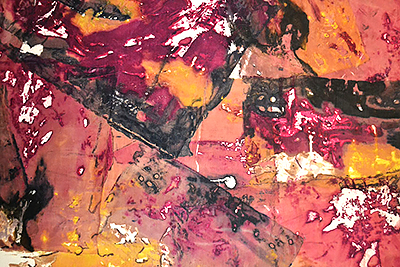Judy Saye-Willis, Minnesota State Arts Board grant recipient shares her work, “From Antiquities to the 21st Century: Natures Gentle Colors” in four exhibits across southern Minnesota from November 17, 2014 to March 15, 2015. (Location details below.)

[ale_alert style=”grey”] This project is about developing natural dye materials and methods that can be used to create art for exhibition. A journey into history will help to understand the challenges that were encountered.
For centuries materials from nature were used to produce color in clothing, paintings and make up. In 1856 William Perkins, an 18 year old English chemistry student, was trying to find a treatment for malaria when quite by accident, he discovered a dye color called mauve. That was the beginning of chemical companies’ production of dyes from coal tar.
The future development of low cost chemical dyes put an end to large agricultural economies that had existed for centuries to produce natural dye materials. Natural dye materials were production crops throughout Europe including madder root for reds and woad leaves for blues. Indigo plants for deep blues were traded and retraded from India to southern Europe to Africa and to the shores of southeastern North America. Brazil wood from Brazil was prized and produced a brilliant burgundy. Forests were pillaged, and the logs put on ships and sent to Europe until the Brazil wood forests were almost gone. When the North and South Americas were colonized cochineal bugs were found to produce the color fuchsia and osage wood for orange.
In one generation centuries of natural dye history was lost. The secret recipes of master natural dyers disappeared and whole economies ceased. The skills, knowledge, cultures and heritage connected to natural dyes were gone. Information is not readily available and the work I have done in my studio has been mainly trial and error in an effort to identify techniques that work.
My research has uncovered the materials and processes used to create the beautiful intricate prints from France and indigo blues and shibori from Japan. Most of the current natural dyers I have met or read about are artisans dying wool for spinning and weaving and some are dying fabrics for clothing and art to wear. Some grow dye gardens while others scour the local country side and/or order dye materials from the few suppliers of natural dye materials and extracts in the US, Canada, France and other international countries. Small quantities of natural dye materials are available today and are used to color fiber, cosmetics and food.
Some local materials I have used for dyeing including rhubarb root, black walnut, sumac, goldenrod, prairie grasses, flowers from local gardens and a local source for pernambuco. I will continue to pursue more chemistry and botany information in an effort to identify regional plants that can be used in the natural dyeing process.
My natural curiosity has lead me to Pliny the elder, a naturalist, philosopher, and historian; Isaac Newton’s theory on light and color; and most recently Michel Garcia , a chemist, botanist and natural dyer from France. So here I am today a multidisciplinary renaissance woman with a fascination for the environment, cultures, science and sustainability. I cannot help but raise questions about the personal choices we make regarding the dye materials and methods used to produce the clothes we wear or the potential for using natural dye materials to create art. [/ale_alert]
A traveling exhibit will take place Nov 1 – March 15 at the following galleries:
[ale_toggle title=”Red Wing Arts Assocation” state=”open”] 418 Levee St. Red Wing Nov 1- Nov 17 Opening Reception: Saturday, November 1, 4-6 pm Gallery Hours: M-F 12-5, Sat 10-5, Sun 12-5 [/ale_toggle]
[ale_toggle title=”The Mantorville Art Guild” state=”open”] 521 N Main St. Mantorville Dec 2 – Dec 23 Artist Reception: Friday December 12, 3-5pm Gallery Hours: Tue-Sat 11-5, Sun 12-5 [/ale_toggle]
[ale_toggle title=”Carnegie Cultural Center” state=”open”] 206 N Freeman. Luverne Jan 6 – Jan 31 Closing Reception: Saturday, Jan 31 2-4pm Gallery Hours: Tue- Fri Noon-5, Sat 1-4 [/ale_toggle]
[ale_toggle title=”The Art of St. Peter” state=”open”] 315 S Minnesota, St. Peter Feb 13 -March 15 Reception: Saturday, February 14 2-4pm Gallery Hours: Tue- Fri 11-6, Sat & Sun 1-5 [/ale_toggle]
Judy Saye-Willis is a fiscal year 2014 recipient of an Artist Initiative grant from the Minnesota State Arts Board. This activity is made possible by the voters of Minnesota through a grant from the Minnesota State Arts Board, thanks to a legislative appropriation from the arts and cultural heritage fund.
